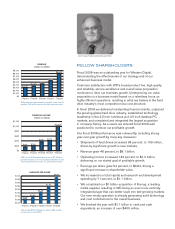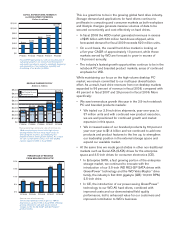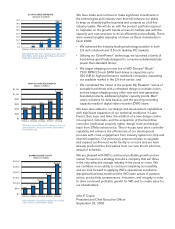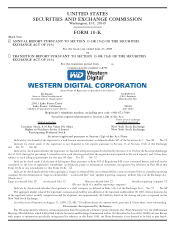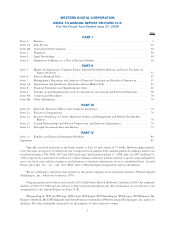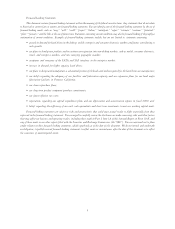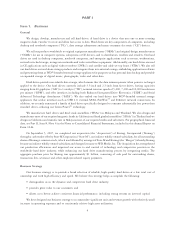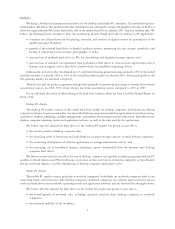Western Digital 2008 Annual Report Download - page 10
Download and view the complete annual report
Please find page 10 of the 2008 Western Digital annual report below. You can navigate through the pages in the report by either clicking on the pages listed below, or by using the keyword search tool below to find specific information within the annual report.PART I
Item 1. Business
General
We design, develop, manufacture and sell hard drives. A hard drive is a device that uses one or more rotating
magnetic disks (“media”) to store and allow fast access to data. Hard drives are key components of computers, including
desktop and notebook computers (“PCs”), data storage subsystems and many consumer electronic (“CE”) devices.
We sell our products worldwide to original equipment manufacturers (“OEMs”) and original design manufacturers
(“ODMs”) for use in computer systems, subsystems or CE devices, and to distributors, resellers and retailers. Our hard
drives are used in desktop computers, notebook computers, and enterprise applications such as servers, workstations,
network attached storage, storage area networks and video surveillance equipment. Additionally, our hard drives are used
in CE applications such as digital video recorders (“DVRs”), and satellite and cable set-top boxes (“STBs”). We also sell
our hard drives as stand-alone storage products and integrate them into external casings, embedding application software
and presenting them as WD»-branded external storage appliances for purposes such as personal data backup and portable
or expanded storage of digital music, photographs, video and other data.
Hard drives provide non-volatile data storage, which means that the data remains present when power is no longer
applied to the device. Our hard drives currently include 3.5-inch and 2.5-inch form factor drives, having capacities
ranging from 40 gigabytes (“GB”) to 1 terabyte (“TB”), nominal rotation speeds of 5,400, 7,200 and 10,000 revolutions
per minute (“RPM”), and offer interfaces including both Enhanced Integrated Drive Electronics (“EIDE”) and Serial
Advanced Technology Attachment (“SATA”). We also embed our hard drives into WD»-branded external storage
appliances that utilize interfaces such as USB 2.0, external SATA, FireWire
TM
and Ethernet network connections. In
addition, we recently announced a family of hard drives specifically designed to consume substantially less power than
standard drives, utilizing our Green Power
TM
technology.
We manufacture hard drives and head stack assemblies (“HSAs”) in Malaysia and Thailand. We also design and
manufacture most of our required magnetic heads in California and head gimbal assemblies (“HGAs”) in Thailand and we
design in California and manufacture in Malaysia most of our required media and substrates. For geographical financial
data, see Part II, Item 8, Note 6 in the Notes to Consolidated Financial Statements, included in this Annual Report on
Form 10-K.
On September 5, 2007, we completed our acquisition (the “Acquisition”) of Komag, Incorporated (“Komag”)
through a cash tender offer by State M Corporation (“State M”), our indirect wholly-owned subsidiary, for all outstanding
shares of Komag’s common stock, which was followed by a merger of State M and Komag (the “Merger”) whereby Komag
became an indirect wholly-owned subsidiary and changed its name to WD Media, Inc. The Acquisition has strengthened
our production efficiencies and improved our access to and control of technology and competitive position in the
worldwide hard drive industry, while enhancing our hard drive manufacturing process by integrating media. The
aggregate purchase price for Komag was approximately $1 billion, consisting of cash paid for outstanding shares,
transaction fees, severance and other employee-related equity payments.
Business Strategy
Our business strategy is to provide a broad selection of reliable, high quality hard drives at a low total cost of
ownership and with high efficiency and speed. We believe this strategy helps accomplish the following:
• distinguishes us in the dynamic and competitive hard drive industry;
• provides great value to our customers; and
• allows us to better achieve consistent financial performance, including strong returns on invested capital.
We have designed our business strategy to accommodate significant unit and revenue growth with relatively small
increases in operating expenses and to consistently achieve high asset utilization.
4



